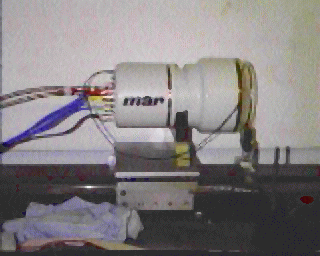
A 165 mm diameter MAR CCD detector was installed on station 9.5 (tunable wavelength) of the Synchrotron Radiation Source at Daresbury Laboratory during August 1999. The new detector replaces the 300 mm MAR image plate. The first users of the CCD were on 28th August 1999 and each group has benefited from the faster readout; six seconds compared with four minutes for the image plate. With average exposure times between three and five minutes on 9.5, the new detector enables collection of approximately twice as much data in the same time as previously. This means great improvements in the quantity and quality of data collected on the station, which is vital especially for Multi-wavelength Anomalous Dispersion (MAD) experiments.

Figure 1. The MAR CCD detector mounted on the optical bench of station 9.5 at the SRS.
As shown in Figure 1, the CCD detector overhangs the translation base by approximately 15 cm. This allows a much smaller minimum crystal-to-detector distance of 81 mm, compared with 230 mm previously. Consequently higher resolution data is now obtainable on station 9.5 (as outlined in Table 1).
|
Wavelength (Å) |
Achievable Resolution with the MAR CCD (Å) |
Achievable Resolution with the MAR IP (Å) |
|
0.8 |
1.05 |
1.40 |
|
1.0 |
1.31 |
1.75 |
|
1.2 |
1.58 |
2.11 |
|
1.4 |
1.84 |
2.46 |
Table 1. Achievable resolution on 9.5 with the 165 mm CCD, compared with the 300 mm image plate detector. Note that the flux at a wavelength of 1.0 Å is approximately three times that at 0.8 Å and the flux at 1.4 Å is approximately five times that at 0.8 Å.
For more information about the CCD detector and station 9.5 in general visit URL:
http://www.dl.ac.uk/SRS/PX/9_5_manual/man.html